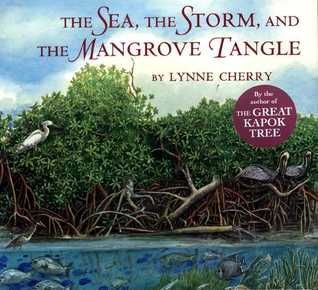What do I look for in a living book?
- Written by someone with a love for the subject who communicates that passion directly to the readers
- Well written, engaging, not dumbed down
- Not just dry facts, but ideas
I know I mentioned Lynne Cherry in my last read-aloud post, but I wanted to shine a brighter spotlight on her. She is an environmentalist and the author and illustrator of many children's books. Our library had four of them, so I am basing my opinions on those four. I would love to hear from you in the comments if you have read others of her books, and how you liked them.
Flute's Journey: The Life of a Wood Thrush was our favourite book so far. I used it as a school book with my six-year-old. He narrated well, perhaps better than any other of his school books so far. A week or two later, he and his four-year-old brother told their grandma about the book, and I was amazed at the details they remembered. Comparing it to the Burgess Bird Book (our regular school book about birds), this book's vocabulary is a little more accessible, though not dumbed down. It has the same level of detail, perhaps more, but that detail is communicated in a straightforward, active story rather than in conversational style. Finally, Lynne Cherry's illustrations are meticulous as well as beautiful, and I appreciated not having to go elsewhere for illustrations of the wood thrush at various stages or for maps of its migration.
Most importantly, this book was a delight for my son. If like us, you are struggling a bit with the style of the Burgess Bird Book in Ambleside Online's Year 1, may I suggest substituting this book for a chapter or two, just for the sake of joy in learning and in narration? You will not be short-changed in the knowledge gained.
The Sea, the Storm, and the Mangrove Tangle is much in the same style as Flute's Journey. It is the story of how a mangrove grows from a propagule into a huge tangle that shelters fish, seahorses, birds, and other wildlife. We read it aloud together, and the boys enjoyed it. I did not require narration, but I think it would work well as a school book too. It also includes maps of where mangroves grow.
How Groundhog's Garden Grew is quite different from the first two books. It is a make-believe story of how a squirrel helps a groundhog grow his own garden. I think it may be aimed at slightly younger children (3 and up). It weaves in many interesting details about gardening: collecting seeds, transplanting, pollination, perennials. The story ends with groundhog sharing his bounty at a big Thanksgiving dinner with all his garden friends. Like all of Lynne Cherry's books, the illustrations in this book are wonderfully detailed. My boys especially liked the pictures of how a seed grows from seed, to seedling, to full-grown plant. I think I'll take this one out of the library again before our next gardening season.
I mentioned at the beginning that Lynne Cherry is an environmentalist. I am not, at least, not in the same sense. (I believe it's our God-given responsibility to care for the earth and its creatures. I balance that with the belief that the earth's resources are there for us to use. I am cautious about environmentalism for its own sake.) The Great Kapok Tree is the book I enjoyed least of all the ones I picked up from our library, though it was just as beautifully illustrated. To be honest, I would have appreciated a straight-forward, honest look at the species of the rainforest and how they are affected when the trees are cut down. I only disliked the way it was communicated in this book, where it seemed like Cherry was trying to manipulate the emotions of her readers and convert them to environmentalism. However, this book has won many honours, and you may like it even if I didn't.
Check out this video of Lynne Cherry working on one of the illustrations for How Groundhog's Garden Grew.


